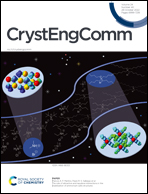Structural phase transition and dielectric relaxation in an organic–inorganic hybrid compound: [(CH3)3NH]4[Fe(SCN)6]Cl†
Abstract
Phase transition materials that can exist in two energetically stable states are suitable for a range of applications in electronics and physics. In this work, we report a new organic–inorganic hybrid compound, [(CH3)3NH]4[Fe(SCN)6]Cl, which undergoes a structural phase transition at about 195 K accompanied with the thermal hysteresis of dielectric bistability as well as anisotropic dielectric relaxation along the crystallographic a-, b-, and c-axis in a broad temperature range, which may be considered as a potential relaxor-type dielectric material. The analyses of the dynamic structures revealed that the structural phase transition was induced by the synergetic effect of orientation of the (CH3)3NH+ cations, displacement of the Cl− anions, and slight tilling of the [Fe(SCN)6]3− complex ions. Among these, the slowly progressive reorientation of the (CH3)3NH+ cations are mainly responsible for the prominent dielectric relaxation behavior. Further studies on dielectric relaxation disclose a rather narrow distribution of the relaxation time and practically a mono-dispersive type dielectric relaxation process, which may be considered as a Debye model.
![Graphical abstract: Structural phase transition and dielectric relaxation in an organic–inorganic hybrid compound: [(CH3)3NH]4[Fe(SCN)6]Cl](/en/Image/Get?imageInfo.ImageType=GA&imageInfo.ImageIdentifier.ManuscriptID=D2CE01150F&imageInfo.ImageIdentifier.Year=2022)


 Please wait while we load your content...
Please wait while we load your content...